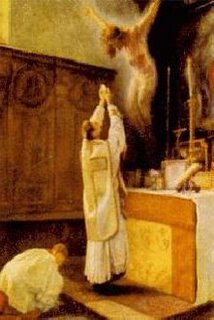
I've revised and extended a previous post of mine in response to a recent editorial I read that advocates the ordination of women to the priesthood. The letter, written by a recently "ordained" priest-ette is embarrassingly deficient from an intellectual point of view but perhaps potent for those who are easily swayed by emotional shrills springing from the liberal Sirens from within the Church.
A recent editorial in my hometown Milwaukee’s local newspaper contained an open letter to Church leaders calling for the full inclusion of women within the Church. The recently “ordained” Bridget Mary Meehan rattled off a litany of pseudo-historical evidence and emotional platitudes that she believes bolsters her claims for why the Catholic Church should ordain women to the ministerial priesthood. Among other things, she calls for greater democratization of the “hierarchical” Church. Her letter was reminiscent of Dan Brown’s revisionist historical approach to Church history, Meehan shrewdly picks and chooses her historical evidence to suit her personal vision of what she thinks the Church should be, according to the narrow prism of the dictates of political correctness. As it is at present, the letter itself displays a glaring ignorance, not only of Church history, but also of basic ecclesiology. Her complaints are the usual talking points which emanate from that particular corner of disgruntled, angry-at-the-world Catholics. I withhold further comment on the embarrassment to which the assertions Meehan has made naturally lead. The nature of a written response limits the amount of space available to address her numberless follies, although nothing would be more easy than to expose them. For those interested in a serious explanation of the Church’s position, Pope Benedict XVI serves as an able guide for understanding the teaching.
The Church, as the mystical body of Christ, for whom He offered Himself on the cross is the central tenet upon which our faith and Sacramental life rest. This teaching has firm roots in Scripture and, in particular, within the Pauline tradition. Pope Benedict XVI elaborates on three sources of this ancient tradition. The first is what he calls the “Semitic conception of the ‘corporate personality.’” In other words, the belief in a common humanity passed down from Adam. As the Pope describes it, this concept of “corporate personality” was deconstructed in modern times somewhat by the philosophy of Descartes, which professed a radical alienation of the individual within the prison of his own thought process as opposed to a united humanity, sharing a common physical and metaphysical nature. A positive development in contemporary philosophy has been a renewed emphasis on the subject as “I” and his necessary relationship to the other, “you,” thus reestablishing the Semitic link between persons, what Pope Benedict refers to as “mutual interpenetration.” He goes on to say, “Thus, the Semitic view of the corporate personality-without which it is difficult to enter into the notion of the Body of Christ-could once again become more easily accessible.”
The Pope then turns to the concepts of “body” and “Eucharist” as the second sources of the Church’s tradition for the mystical Body of Christ. The Lord literally feeds His people with His bread, His true Body. Eating is that act which allows for an intimate intermingling of two subjects. As the Pope explains, “The formula ‘the Church is the Body of Christ’ thus states that the Eucharist…forever remains the place where the Church is generated.” The act of communion unites the believer with the Head, who is Christ, together with the other members as well. Thus, one sees a complete fusion of Christ with the entire Church, that is to say, with the body and her members.
This leads us to the final source of the tradition, what the Pope identifies as “the idea of nuptiality.” Here one sees the fulfillment of the other two sources in the intimate bond of love between the Groom, Christ, and His bride, the Church. “Christ and the Church are one body in the sense in which man and woman are one flesh.” And it is here that the heart of the Church’s teaching on the Body of Christ reaches its apex. For the union between Christ and the Church is so intimate that we speak of it in terms of the physical and spiritual unity shared between man and woman in the nuptial bond, as the book of Genesis asserts, “For this reason the man shall leave his father and mother and cleave to the woman, and they shall become one flesh.”
So in light of these truths, the Church’s position regarding the ordination of men to the priesthood is very clear and makes complete sense. The priest, standing in persona Christi, offers Himself, His very Body, to the Church as His bride in the Holy Sacrifice of the Mass. It becomes patently ludicrous to ponder the unseemly spectacle of a woman standing in place of Christ, offering the Sacrifice of the Mass to the Church as bride. The Church has always been viewed as feminine in nature as the bride. Within the context of the “nuptiality” between the Church and Christ, by the very nature of things, the priest must be male, as he places himself at Christ’s disposal to work through him directly in this act of gift of self and love toward His one bride, the Church. No amount of historical chicanery, misplaced sentimentalism, or lofty calls for the democratization of the Church can alter the immutable truth about the nature of Christ and his Bride, the Church. Meehan, and those who follow her theological sophistry, should at the very least have the integrity to recognize this. If they refuse to, no one is forcing them to stay.


No comments:
Post a Comment